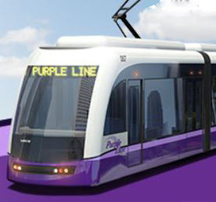Why Not Cut-and-Cover in Chevy Chase?
The Purple Line will run above ground between Bethesda and Silver Spring, alongside an improved Capital Crescent Trail. This route uses the right-of-way of the old Georgetown Branch railroad through Chevy Chase.
The Maryland Transit Administration is carefully planning what the trail will look like alongside the Purple Line. Attractive landscaping and retaining walls, frequent trail crossovers, grassy rail beds and other techniques exist that will ensure that the Georgetown Branch segment continues to feel like a 66’ to 100’ linear park.
In the past, some political candidates have advocated “cut-and-cover” construction for this portion of the Purple Line. This is a method of underground construction in which a trench is excavated from the surface, the rail line is built in the trench, and a roof is built over the trench.
MTA rejected cut-and-cover construction for many good reasons. Although it is usually considered less expensive than deep tunnel boring, it is still much more expensive than building at grade. Moreover, site-specific conditions in the Chevy Chase section of the Purple Line create additional problems with cut-and-cover construction above and beyond the cost:
- The trench must be wider than the tracks because side walls are required. Tree roots can extend under at-grade railroad tracks but are blocked by cut-and-cover tunnels. For these reasons, cut-and-cover construction in a wooded area like the Georgetown Branch right of way will cut down more trees than surface construction.
- For structural support, there will be a six inch layer of cobbles under the light rail tracks. This layer is very permeable and acts as a drain if it is below the water table. With cut-and-cover, this layer will be below the elevation of Coquelin Run and, depending on soil conditions and the distance between the tracks and the watercourse, could drain water out of the stream. The usual engineering fix for such problems is a grout curtain, but this is expensive and could block ground-water recharge into the creek from the north side of the tracks. The risk that these problems will cause Coquelin Run (especially its upstream portion which is closest to the tracks) to dry up in less rainy seasons could be assessed by geotechnical and hydrogeologic studies, but such investigations were not performed because other disadvantages were sufficient to rule out cut-and-cover.
- East of Connecticut Avenue, drainages cross beneath the existing rail grade that would be blocked by a cut-and-cover trench.
- A trench excavated beneath the Air Rights Building or the East-West Highway bridge would undermine these structures; so light rail must be built at grade at these two locations. The preferred grade for light rail tracks is no more than 3%, although grades up to 6% are possible where geometric constraints require it. At a 3% grade, there is barely enough room between the two structures for a track to descend 30 feet and rise back to grade. Consequently (unless the East-West Highway bridge is demolished and rebuilt at great expense and great inconvenience to commuters) a light rail line built by cut-and-cover would still be above ground along at least half, and very possibly all, of the portion of the right of way that adjoins the Town of Chevy Chase.
Finally, there is an important issue of equity about whether the Purple Line is above or below ground in Chevy Chase. This right of way, with its very attractive view, was purchased with everyone's tax money and belongs to all of our citizens. The future riders on the Purple Line are much more numerous than the future trail users (who are in turn more numerous than the current users of the unpaved interim trail). Surely, the many Purple Line riders have the same right to enjoy the beautiful Chevy Chase scenery on their way to work as the somewhat-fewer trail users and the very few neighbors.
Some undergrounding of the Purple Line will be required to ensure good transit service for East Silver Spring. In these areas, there is no pre-existing rail right of way, and at some locations at-grade construction is not feasible due to steep slopes. ACT supports MTA's decision to run the Purple Line at-grade on Wayne Avenue with a short tunnel section east of Sligo Creek.
Building the Purple Line at grade is fully consistent with federal legislation. The design “ensures a safe and accessible pedestrian-bicycle trail” as specified in recent federal legislation. There are over 60 trails in the US adjacent to active rail lines according to the Rails-to-Trails Conservancy. Undergrounding this segment, on the other hand, would cost a huge sum of money and would put the project at risk of being declared cost-ineffective by the Federal Transit Administration.

